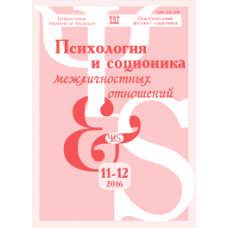Номер № 11-12/2016 журналу «Психологія та соціоніка міжособових відношень»
Питання освіти
Мегедь В.В.
Модель оптимізації формування та навчання дітей різних вікових груп
Соціонічні підходи можуть підвищити ефективність виховання та навчання дітей. Запропоновано нову концепцію для виховання гармонійно розвинених та талановитих дітей шляхом розвитку їх уроджених здібностей найбільш адекватними способами у найбільш підходящі для цього вікові періоди.
Ключові слова: соціоніка, вікова психологія, виховання, навчання, діти , школярі.
Соціоніка в дитячій
Єрмак В.Д.
Етапи формування та розвитку психіки в соціонічній моделі
На основі моделі А розглядається гіпотеза повного життєвого циклу розвитку психіки — від появи структури психіки до її наповнення реальної інформацією. Запропоновано повну модель та системний механізм функціонування психіки в процесі її розвитку та наповнення інформацією. Моделювання ще раз підтверджує важливість створення кожному етапі розвитку психіки інформаційного середовища, адекватної конкретному ТИМ психіки. Результати можуть бути основою нових експертно-консультативних, педагогічних, кадрових та інших методик.
Ключові слова: психіка, моделювання, структура моделі, етапи розвитку, інформаційне наповнення, спотворення типу психіки, заданість типу психіки.
Інтертипні відносини
Боброва Н.С.
Відносини у сім'ї. Спосіб вирішення конфлікту із застосуванням соціоніки
Описано взаємини в сім'ї з урахуванням особливостей структури психіки матері та дорослого сина. Розглянуто причини виникнення конфліктів та непорозуміння між ЛСІ (LF) та ІЕЕ (IR). Показано шляхи уникнення конфліктів та способи зробити життя більш комфортним.
Ключові слова: соціоніка, тип інформаційного метаболізму (ТІМ), модель А, інтертипні відносини, ЛСІ, ІЕЕ, конфлікт.
Шлаїна В.М.
Картина відносин зсередини
Кожне інтертипне відношення проявляється через певний тип ІМ. Розглянуто трансляцію людиною як носієм типу інформаційного метаболізму образу інтертипного відношення своїх батьків. Наведено приклади такого роду трансляції у вигляді посилення у дитини якостей, властивих ТИМу, що відповідає інтертипному відношенню батьків.
Ключові слова: соціоніка, інтертипні відносини, тип інформаційного метаболізму, відносини батьків, тип — носій відносини.
Методи соціоніки
Карпенко О.Б.
Про ознаки Рейніна
Факт поділу соціону на квадри та існування ознак « ;екстраверсія–інтроверсія» та «раціональність–ірраціональність» для соціонічних типів неминуче призводять до виявлення та ознак Рейніна. І ознаки Рейніна, і модель А виражають єдину структуру соціону і типу інформаційного метаболізму через різні формальні описи.
Ключові слова: , ознаки Рейніну, раціональність, ірраціональність, екстраверсія, інтроверсія.
Соціонічні портрети
Зайцев В.С.
Соціонічний тип Марини Цвєтаєвої
Зроблено спробу визначити соціонічний тип Марини Цвєтаєвої щодо її віршам, щоденникам та спогадам сучасників. Описано методику визначення ТІМу заочно шляхом розгляду семантики в письменницькій творчості людини.
Ключові слова: соціоніка, тип інформаційного метаболізму, семантика, квадрові цінності, ознаки Рейніна, діагностика типу.
Математичні методи в соціоніці
Мінаєв Ю.П., Даценко І.П., Лісіцин Р.В.
Вправи на дослідження властивостей групи операторів класичних інтертипних відносин
Ця стаття є третьою в задуманій серії публікацій, присвячених організації занять зі студентами, на яких вони знайомитимуться з математичним апаратом соціоніки. Цього разу завдання будуть пов'язані з розглядом низки понять з математичної теорії груп на прикладі групи операторів класичних інтертипних відносин.
Ключові слова: центр групи, нормальні підгрупи, суміжні класи.
Фізика свідомості та життя
Букалов А.В.
Проблема свідомості та квантові моделі психіки
Подано огляд теорій психіки та свідомості. Запропоновано голографічну модель мислення, що включає психічні функції К.Г. Юнга А. Аугустінавічюте. Показано, що нейронні структури не можуть забезпечити психічні феномени, що спостерігаються, і феномен свідомості. Описано квантову модель фізичного субстрату психіки, що складається з бозе- та фермі-конденсату легких елементарних частинок. Вивчення квантових основ свідомості дасть можливість створити нові квантові комп'ютери, що за своїми характеристиками наближаються до можливостей людського мислення.
Ключові слова: нейрони, голографія.
Психологія та соціоніка 11-12/2016
- Модель: выпуск журнала «Психология и соционика…»
-
$3.00
- Ціна в бонусних бали: 30

